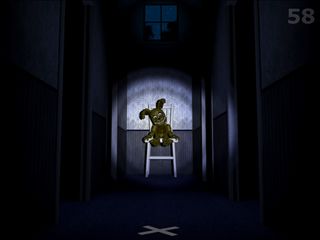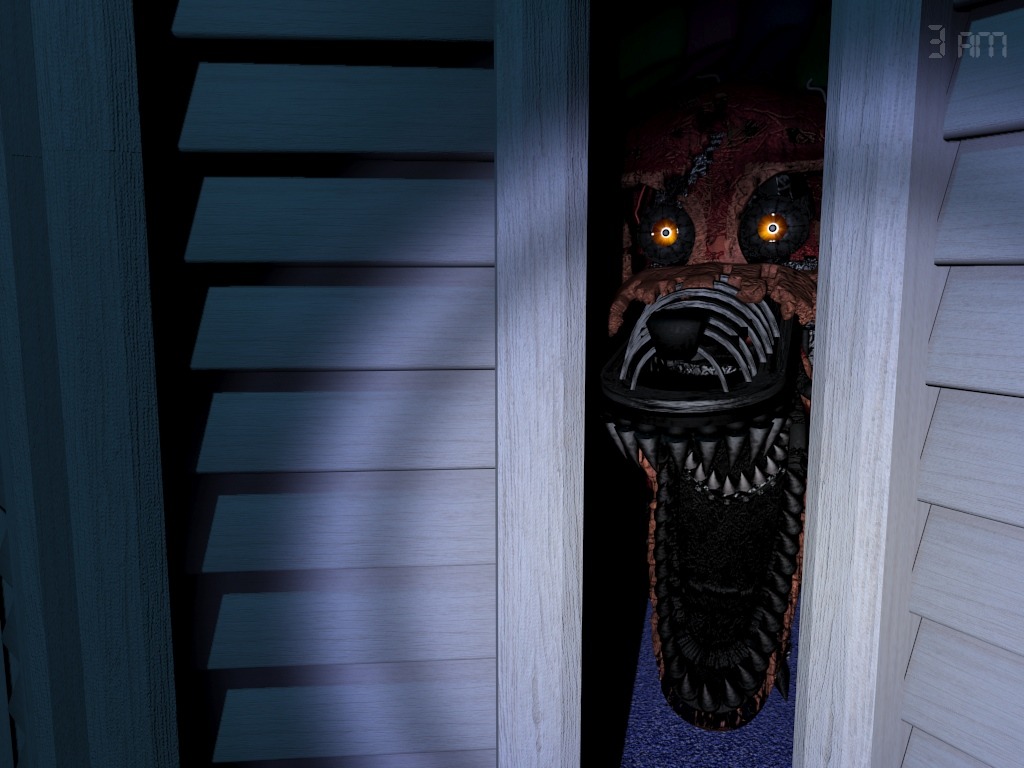Our Verdict
The biggest frights of the ever-expanding series without quite the same unease and variety.
PC Gamer's got your back
What is it? The fourth jump scare-filled horror
Price: $8/£5
Developer: Scott Cawthon
Publisher: Scott Cawthon
Reviewed on: Windows 7, Core i7, 8GB RAM, GTX 670
Multiplayer: None
Link: http://scottgames.com
The tensest moment in Five Nights at Freddy’s 4 is a one-second lean. I’m leaning out of a child’s bedroom, a sharp departure from the Formica wasteland of Freddy Fazbear’s pizzeria, peering down a hallway swallowed in darkness. I may as well be staring into a lion’s mouth. When I risk a glance out one of the two flanking doors into the dark corridors beyond, my perspective skews unnervingly. I can imagine my hands hugging the wall, an ostensible anchor against the nightmares bumping in the blackness.
Nothing jumps out at me this time. The moment passes, and it's back to the same movements and mouse-clicks I’ve repeated dozens of times before. I should’ve yawned five minutes ago, but soon I’m once more forcing my heart back down my throat for my next peek outside. This repeats for quite some minutes. If FNAF 4 needed a box blurb, it’d read something like “a rollercoaster of apprehension.”
FNAF 4’s composition is another rivet in the series’ steel-clad design which immortalized its Let’s Play legacy in a few short months: five 8-minute nights of staying put in a room while fending off a quick death (and a nasty jumpscare) from creepy, walking animatronic animals using careful surveillance and snappily blocking access to whatever shuffles close. Loud screeches and terrifying robotic visages are common, so a strong resolve helps. Mostly.
Boy meets demon
Above anything, developer Scott Cawthon’s tenacity at constantly tweaking his formula for horror is almost Kubrickian in its meticulousness. FNAF 4’s fundamentals stay firmly acquainted—a familiarly symmetrical room; the reprise of Bonnie, Chica, Freddy, and Foxy as primary antagonists; the usage of doors as a primary defensive mechanic—but its differences offer a refreshing new presentation of the risk-reward seesaw of its predecessors.
Replacing the ever-troubled pizzeria from previous games is the nighttime bedroom of a kid who both substitutes for the hilariously underpaid security guard as the main character and clearly establishes his traumatic phobia of Freddy’s friends with a constant Binding-of-Isaac-esque flow of tears. In a flagrant flouting of the status quo, the camera system is removed entirely. Checking for an impending attack involves running up to a door, leaning out, and clicking on a flashlight (thankfully with unlimited battery power) or slamming the door shut at the precise moment I anticipate something lunging for me.

As before, staying alive demands familiarization with each animatronic’s behavior. Where sight and constant camera tracking facilitated this in earlier games, FNAF 4 tosses that away for a different angle: sound. Audio cues—muffled footsteps, the metallic tinkling of shifting kitchen pans, a huff of breath from something Right Beside You—indicate when to use the flashlight or seal a doorway. Being proactive is essential; a single mistake invariably delivers a booming fright. I liked that avoidance of randomness in failure, as my actions and choices solely contributed to whether or not I’d soon jump out of my chair.
And that’s really what Cawthon is best at: ensuring crystallized snapshots of stomach-dropping terror. FNAF 4 uses the sensitivity of your senses to prod out a panicked yelp every time. Does it work? Absolutely. It’s absurdly rudimentary: straining to hear something barely above a whisper connects into a skull-shaking blast of sound and a horrible monster face stretched across the monitor. Of course it works.

But it’s a bit worrisome to see an overall pivot away from what made the series so attractive in favor of a single, static mechanical loop across all five nights. The camera system, although imperfect—as later nights grew more difficult, staring too long at the video screen likely meant death—greatly defined the series’ identity. In FNAF 2, checking vents and winding the music box were integral counterparts to the cameras. FNAF 3 piled on the sinister inevitability of tracking a stalking killer.
In many ways, the Five Nights games require a certain respect for their atmospheric lore, a twisted menagerie of cloudy dates, murder mysteries, and inter-relationships nearly as spaghettified as a Metal Gear Solid cutscene. Stepping into Freddy’s world, like flipping open a King novel or tuning into a Carpenter classic, is an investment in putting aside disbelief and reveling in the supernatural guesswork of the genre. That’s sadly tougher to pull off in Five Nights at Freddy’s 4; the humdrum repetition of the same sequence over and over—door, listen, flashlight, repeat—is too much of a chore to fully pull me in. It’s certainly the scariest of the four, but the subtle uneasiness and self-doubt so tellingly accomplished in its older brothers is diminished.
The biggest frights of the ever-expanding series without quite the same unease and variety.
Omri Petitte is a former PC Gamer associate editor and long-time freelance writer covering news and reviews. If you spot his name, it probably means you're reading about some kind of first-person shooter. Why yes, he would like to talk to you about Battlefield. Do you have a few days?

The 11 big FPS games of 2025

Wormhole is an impeccable arcade revival of Snake that plays like it fell off the back of Derek Yu's van

My Summer Car, the absurdly detailed Finnish life sim about vehicle maintenance and drinking in your underpants, smashes into 1.0 after nearly a decade in Steam early access
